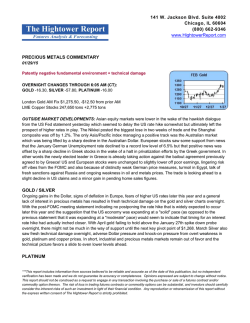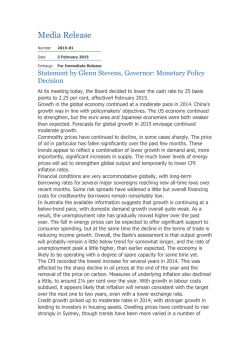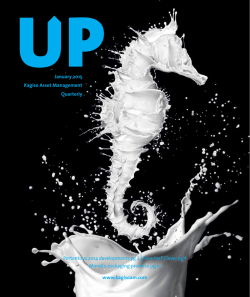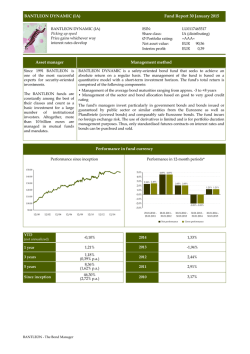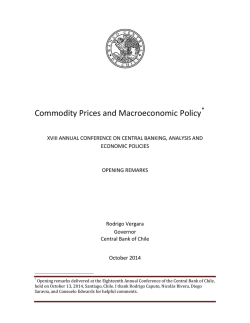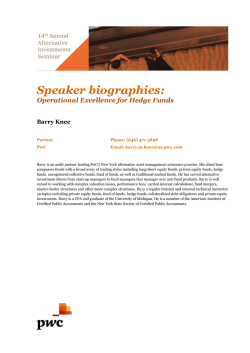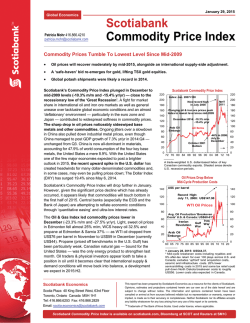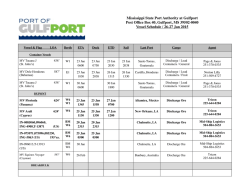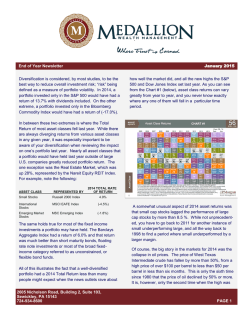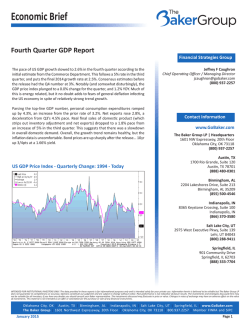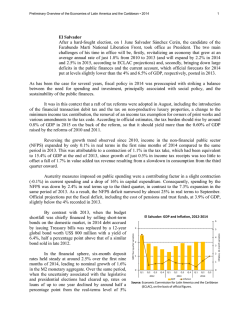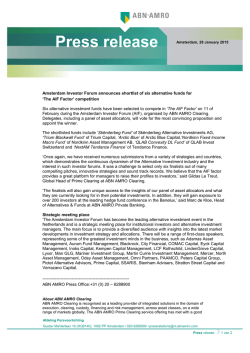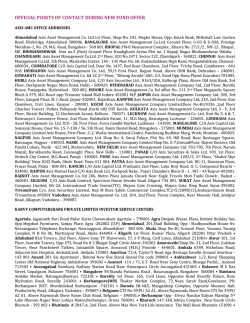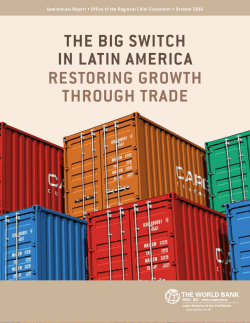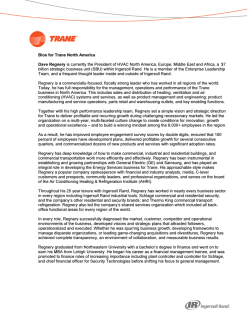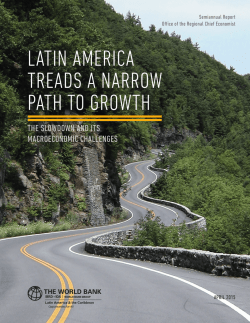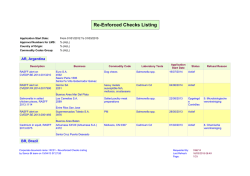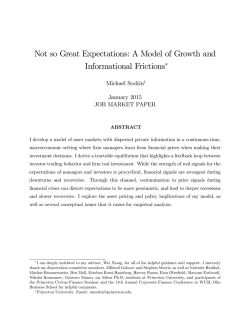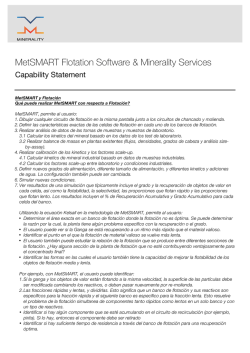
read more - Kagiso Asset Management
January 2015 Kagiso Asset Management Quarterly Portentous 2014 developments pg 1 Four-leaf Clover pg 4 Mondi’s packaging prowess pg 13 www.kagisoam.com Portentous 2014 developments Gavin Wood - Chief Investment Officer After persistent trends and low volatility since the financial crisis, 2014 presented market dislocations and structural changes that we believe have important implications for the course of financial markets, whose participants seem somewhat complacent since ‘momentum’ has been the winning strategy for so long. We highlight some of these dislocations and changes below. 1 Portentous 2014 developments The US passed on the QE baton Foreigners began selling SA bonds via the purchase by central banks of financial instruments from foreigners sold R71.7 billion of bonds in 2014. Coinciding with Quantitative easing (QE), injecting liquidity into the economy the private sector, has been executed on a grand scale since the financial crisis (see chart below) - at a time of near zero interest rates in the world’s largest economies. After many years of foreign inflows into our bond market, these outflows, the rand depreciated by 9.3% (to the US$) to its worst level since 2001. Receding foreign liquidity will make our government’s budget deficit more difficult to finance. The US Federal Reserve has purchased US$3.7 trillion between Emerging market equities also saw foreign outflows of magnitude of this intervention is staggering, given that the US into SA, at R13.3 billion, were positive. However, this may have November 2008 and October 2014 (QE3’s conclusion). The economy (GDP is US$17.6 trillion) and bond market (103% public debt:GDP) are the world’s largest. The real economy benefits of US QE have, in our view, been mixed and of diminishing effect through time, but the impact on asset prices has been massive. US$25 billion in 2014, while, in contrast, foreign equity inflows had more to do with internal problems in our emerging market peers (Russia, Brazil, Turkey, Thailand) than the absolute prospects for our companies. China’s economy decelerated further Having grown GDP at rates of 8%-10% pa for over a decade In 2013, the Bank of Japan began its enormous QE programme (slowing to below 8% in 2013), China’s growth rate headed and the European Central Bank tentatively began asset towards the 7% level in 2014. Growth is likely heading lower as purchases in 2014, with widespread expectations of significant the economy needs to absorb excess capacity, deleverage and sovereign bond purchases to come. This significant structural change highlights the better state of the US economy and has precipitated a sharp strengthening of the US dollar against the yen and the euro. The net effect should be a tightening of rebalance away from fixed investment. China’s property activity slowed in 2014, housing prices declined and new residential construction fell. Limited fiscal policy (infrastructure investment) and monetary policy (lower bank reserve requirements and an global liquidity conditions, given the relative magnitude of the interest rate cut) stimulus measures were introduced. QE programmes, which should be negative for asset prices. Different directions for central bank balance sheets Central bank assets as a % of GDP 60 50 Bank of Japan 40 European Central Bank Bank of England 30 US Federal Reserve 20 10 2010 2011 2012 2013 2014 Source: BCA Research and Kagiso Asset Management research Commodity prices fell sharply up some 20% of imports. The large relative oil price decline commodity consumer, came as 2014 saw an increase in supply impact and, together with lower maize prices, will dampen price The growth deceleration in China, the world’s largest non-oil of many of the commodities it imports. The result was large commodity price falls, with iron ore and oil prices almost halving and thermal coal down 22%. Precious metals were little changed in 2014 off already low levels as supply was curtailed. The oil price decline is particularly important for the world (graph below) should result in a slightly positive trade balance inflation, enabling the SARB to raise rates more slowly. In South Africa Local developments of particular importance for financial markets were: the start of the SARB rate hiking cycle; economy as it is the largest commodity traded by value. The National Treasury announcing ‘austerity measures’ in its cause of the price decline was increased production from North America at a time of weak demand from Europe and China and growing use of substitutes (natural gas and renewables), with OPEC making no change to their production intentions. October mini-budget in the form of an expenditure ceiling and imminent tax rises; major splits in organised labour with the NUMSA expulsion from Cosatu and the emergence of non-aligned AMCU, whose perceived success with its platinum mine strike is These material commodity price declines will have significant fuelling a major recruitment drive from established unions implications for their respective consuming and producing in various other sectors; and countries and companies. Iron ore producers, eg Brazil and Australia, will see export revenues decline. Large net oil exporter economies such as Saudi Arabia, Russia, Nigeria, Angola, Columbia, Mexico and Venezuela will struggle as they are very concentrated around oil production. Oil price falls will particularly benefit large net importers, such as Europe and Japan. South Africa’s exports are dominated (roughly 60%) by iron ore, thermal coal, platinum group metals and gold, while oil makes the demise of African Bank Investments, which should serve to reduce the extortionate returns earned by unsecured credit providers in SA, to reorganise the furniture retail industry and to remind bond and preference share investors to consider credit risk. Given these structural changes, 2015 has begun with raised market volatility and our clients’ portfolios are therefore positioned for a very different environment to the one that has prevailed in recent years. Falling commodity prices 130 12 120 Rand US$ per tonne 110 100 10 90 80 9 70 60 8 Dollar commodity prices based to 100 11 Rand dollar (LHS) Platinum Gold Oil (Brent) Iron ore Thermal coal 50 7 Dec 11 2008 2013 Jun 12 Global average Dec 12 Jun 13 Dec 13 Jun 14 40 Dec 14 Source: Bloomberg and Kagiso Asset Management research Kagiso Asset Management (Pty) Limited Fifth Floor MontClare Place Cnr Campground and Main Roads Claremont 7708 PO Box 1016 Cape Town 8000 Tel +27 21 673 6300 Fax +27 86 675 8501 Email [email protected] Website www.kagisoam.com Kagiso Asset Management (Pty) Limited is a licensed financial services provider (FSP No. 784). Reg No. 1998/015218/07.
© Copyright 2024
